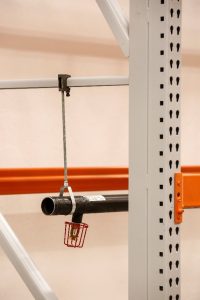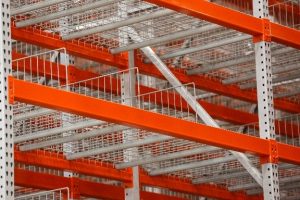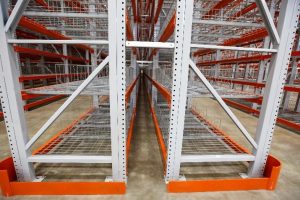
You’ve made it through the design phase and the always fun budgeting process but how do you make sure that when the rubber meets the road… or shall we say, the steel meets the concrete, that your pallet rack system will go up as expected? There are several recognized industry tips and processes that you should expect whether you are self-installing the system or hiring professionals. Here’s a good guide of the basics for proper pallet rack installation.
A given before rack installation is that your rack system meets the various codes and regulations to insure you can start the project… until then, you are not fully at the installation phase.
Staging
The first step of installation is Staging. Staging refers to preparing the rack and the facility for the installation process.
- Check that all the materials have arrived and are in good condition. If you are building in phases then do this for each phase of the install. Waiting on replacement parts can significantly throw off your installation schedule so make sure this inventory is completed as soon as possible upon receiving the system components.
- Check for floor imperfections or sloping. A slab of at least 6” meets the minimal requirement for suitable anchoring of regular-duty pallet racks.
- Layout the “starter bay” on the warehouse floor to get a visual confirmation that sufficient room is available for the rack and aisles to safely accommodate your actual vehicles and pedestrian traffic. Measure the length and width of the racking on the floor with chalk lines. Down-aisle chalk lines should be made at the front face of the rack columns from the start line.
Pallet Rack Installation Basics

In-Rack Sprinkler
Follow all manufacturer required installation procedures specific to your racking system; however, there are general guidelines and accepted practices to be aware of before beginning your rack installation.
- Install the first rack bay, starting with the uprights. Once the uprights are in place, it is helpful to mark the spots where the beams will be affixed.
- Before installing the load beams, ensure that the beams will be adequately spaced to allow room above the load for lifting or depositing the pallet. Also make sure that the load lift will not interfere with sprinklers, light fixtures, or any overhead obstacles.
- Then begin installing the beams. Load beams must be fully engaged on the upright and installed with proper safety pins if installing a roll-formed rack system.
- It is important that the rack is plumb and level before tightening nuts and bolts. Check to see if diagonal post-to-post measurements within the bay are equal at horizontal planes near the ground and at the top of the uprights. A vertical tolerance of 1/8″ in 4 feet is generally accepted as level in most applications. Where columns need to be raised, shims must be inserted between the baseplate and floor to make solid contact (see Step 7 below).
- Make sure all bays are plumb before anchoring… and confirm that the column protectors are not

Anchored Upright
required to share a common anchor with the upright. Depending on the type of column protector it may need to be installed current with the rack installation or after the bays have been erected.
- Every baseplate must have at least (1) anchor though the number of anchors and size of the anchors should be specified by the engineer in the rack design. Extra holes in the baseplate allow for re-anchoring if the current anchor gets damaged or if the anchor bends during installation.
- Shim plates can be installed beneath the baseplate to level the rack if it is resting on uneven flooring. The shim needs to be equal or greater in size to the size of the baseplate. See RMI guidelines in cases where shims must be stacked to achieve plumb.

Ok to Proceed
-

Wire Deck, Dividers and Pallet Supports
After confirming that the first bay is correct, move on to building the additional bays… always confirming that they are plumb and level before moving on.
- Pallet support materials, such as crossbars or wire decking, should be installed after the rack row frame and beam installation is complete. Note that local fire ordinances may require wire decking vs solid material as it allows for sprinkler water to pass through. Any decking or support products must be secured in-place according to product manufacturer guidelines. Installers are never to stand on the wire decking or supports.
Tying it All Together
Wall ties vs overhead ties… and what about row spacers?
- If you are building a single row of pallet rack, Apex NEVER recommends anchoring the rack to

Back-to-Back Pallet Rack with Row Spacers
the building structure. This puts stress on the building wall that it most likely is not designed to support. If a single row needs to be tied off it should be connected to adjacent rack with an overhead row tie, unless the building engineer reviews and approves of wall ties. Overhead ties can serve as a stability tool, together with ensuring proper alignment of the frames.
- Row spacers come into play when you are building selective pallet rack in a back-to-back configuration. The area between the backs of the two racks is called the flue space and it must remain open to meet fire safety regulations. Row spacers are secured within that area and should be positioned at brace panel points starting at the second horizontal upright brace elevation (approx. 48”- 60” from ground) and then at every second horizontal brace panel point thereafter (approx. 84” to 108” spacing). Flue spaces 24” or wider will need heavy-duty spacers with additional hardware requirements.
The Plaque of Success

Load Capacity Placard
The rack manufacturer is responsible to supply load plaques for the rack system, but it is the responsibility of the rack owner to display load plaques.
- Load plaques should be placed in prominent locations on every aisle and for every rack configuration.
- If any structural changes are made to the rack, new charts should replace the old ones with the updated capacity references.
Ultimately, if you find that you need an experienced pallet rack installation team to handle your project, the Apex team is here to help. We offer full service support from system design, project management, inspection/audit and repair services to single project installations. So, give us a call and we’ll get your project up and running smoothly and efficiently.

